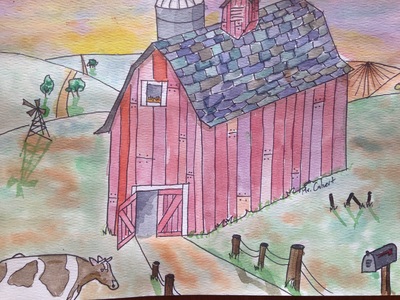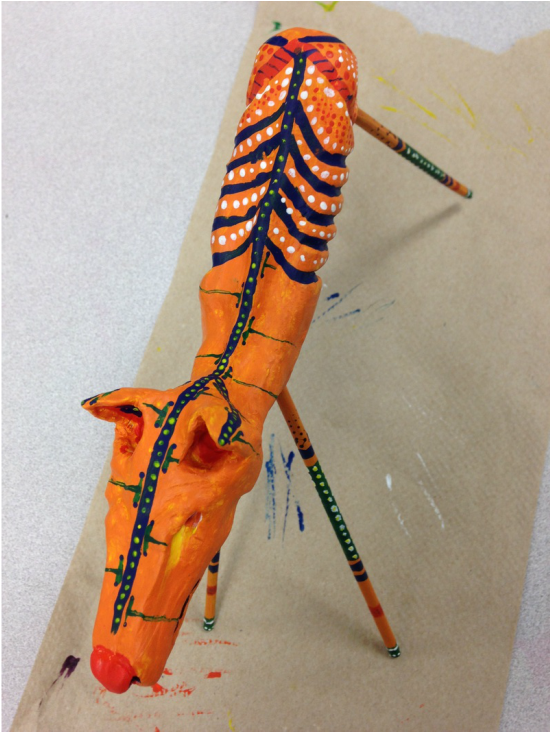|
This was another unit designed by Kathy Bareis that I got to teach during my student teaching experience. After building up brush control from our Chinese watercolor unit, we jumped into making barns. We talked about spatial perspective and how things get smaller the further they go back into the distance. The students' barns had to have two sides, be drawn as large as their hand, and have a side of their barn drawn at an angle. Then then added barn boards, nails, and shingles to their barns. Lastly, they had to draw at least three objects in front and three objects behind their barn. Then we taught them two watercolor techniques. The wet-on-wet technique was used to paint the sky and ground. Students needed to make observations of the colors they were using. If their sky looked stormy then their ground should reflect that. A darkish sky should have a darkish ground and vice versa. The other painting technique we showed them was graphic style. This technique uses a dry paper rather than a wet one. They used graphic style to paint everything else, such as animals, shingles, barn boards, etc. Shingles and barn boards were painted with three or four different colors so that they weren't all the same. Each shingle and barn board was also painted individually. Students were expected to have a light and DARK side (cue Darth Vader voice) on their barn. Lastly, we added layers to our painting by creating shadows that run away from the sun. Shadows were added to objects on the ground, under the roofline, under some shingles, and in door/window openings.
0 Comments
This is a unit that was designed by my cooperating teacher, Kathy Bareis, that I got to teach to my sixth graders. My sixth graders were tickled pink when I told them that we would be working with clay. We practiced making clay heads and bodies of animals/creatures for two or three days. These practice days I kept a tally of how many of the heads/bodies were 'proficient or advanced' for each class to invoke a little bit of classroom competition. The students were eager to come into class and find out which class had won the previous day. The students were expected to create animals/creatures that had ears, mouths, eyes, and noses on the face. The bodies had hips and shoulders that were separated from the belly. They also were asked to create insertion points and tab slots so that they could add extra embellishments to their animals such as tails, horns, spikes, etc. The animals were balanced on four long legs made from cut dowels. The animals were left out to dry with the legs still in them. Then the legs were removed right before firing. After they had been fired, students painted patterns onto the legs and bodies using acrylic paint. To finish off the project, 13 different backgrounds were printed off that the students could photograph their animals in front of. They then wrote folk tales about their animals. they were encouraged to include props and their classmate's animals into their stories. Eventually, Kathy would like to compile pictures of the animals and their stories and publish them in a book for the school library.
We did a seven day long Chinese watercolor unit with the sixth graders. The major theme of the unit was to practice brush control for another upcoming unit that we will be doing. Throughout the project, students had the opportunity to paint their orchids with traditional bamboo brushes. We slowly built up the unit, first starting with two or three days of mixing various hues of green to paint leaf shapes. The students really needed to focus on making the leaves thin-to-thick-to-thin. This meant that they needed to be aware of the pressure that they were using on their brush. We then spent a couple days painting flowers and lightly using chalk to color the background. Lastly, they had two days to paint two final compositions. They were expected to use at least three hues of green and flowers that had similar colors and were made of two or three hues. The stems to the flowers needed to be thinner than the leaves and the background needed to be lightly chalked. Lastly, they matted their work on a piece of paper that they thought went well with their painting. |
Devon CalvertHarmony and Consolidated Elementary Art Teacher in Milton, WI. UW-Eau Claire graduate. WAEA President. Apple Teacher. ArchivesCategories
All
|












 RSS Feed
RSS Feed
